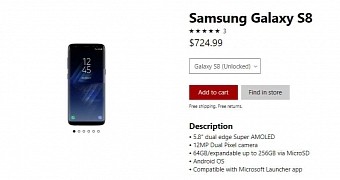Microsoft has already confirmed that while it’s committed to Windows phones, it won’t release any new features to Windows 10 Mobile or new hardware in the near future, so its own mobile platform is pretty much in maintenance mode right now with no consumer future in sight.
In the last 12 months, however, Microsoft has adopted a different mobile strategy that doesn’t necessarily involve its own mobile operating system, but those developed by rivals, including iOS and Android.
After launching the majority of its services on these two mobile platforms, Microsoft took everyone by surprise earlier this year when it started selling the Samsung Galaxy S8 in its own retail stores as part of a collaboration with the South Korean phone maker. In return, Samsung launched a Microsoft-branded version of the Galaxy S8 and offered a number of apps pre-installed, such as Skype and Office.
And today, Microsoft shows its love for Android devices once again, as the company has apparently started selling the Galaxy S8 online as well, both unlocked and with a contract. Microsoft offers the same prices as Samsung for the Galaxy S8 lineup, and you can get the device with a Verizon or AT&T plan.
Shipping with Microsoft apps
Obviously, Microsoft advertises the Galaxy S8 as the right device to experience its services on an Android phone, listing this model as “compatible with Microsoft Launcher app” (as if the other Android devices aren’t).
While it makes sense for Microsoft’s business model to sell Android phones in its stores, both physical and online, hardcore Windows phone fans see this as another confirmation the company is no longer committed to having its own mobile platform.
Surprisingly, Microsoft talks big about the Galaxy S8 and says the screen is “infinitely amazing,” with the device offering “security that you can trust.” This is clearly unexpected from a company that has its own rival mobile platform, but when looking at the bigger picture, it makes sense given that Microsoft actually wants to sell that device.

 14 DAY TRIAL //
14 DAY TRIAL //